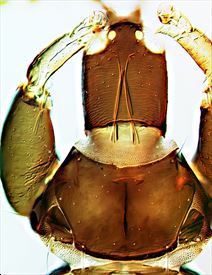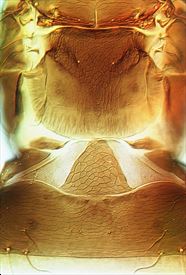
Antenna

Male head & pronotum

Male, meso & metanotum, and pelta

Female metanotum & pelta

Thoracic sternites
Distinguishing features
Female fully winged and with wings variously reduced in length. Body dark brown, tarsi and apex of fore femora paler; antennal segments III–V yellow on basal half, VI yellow at base; major setae pale brown; fore wings shaded, particularly near base. Head longer than wide; dorsal surface with faint lines of sculpture; ocelli present; compound eyes larger dorsally than ventrally; postocular setae not differentiated from minor setae; cheeks with pair of thorn-like setae in basal third; maxillary stylets close together, retracted to compound eyes; maxillary guides stout, with a narrow bridge. Antennae 8-segmented; segments IV–VI each with a distinct pedicel; segment VIII not strongly narrowed at base; segment III with 1 sense cone, IV with 3 sense cones. Pronotum sculptured near posterior margin; major anteroangular, epimeral, and posteroangular setae weakly expanded at apex, usually rounded, epimerals longest; basantra absent. Mesopresternum divided into 2 lateral plates, sometimes faintly joined. Metanotum strongly reticulate; metathoracic sternopleural sutures reaching about halfway to hind coxae. Fore tarsal tooth absent. Fore wings, when fully developed, with 1–12 duplicated cilia; subbasal setae S1 and S2 long, weakly expanded, S3 shorter, finely acute. Pelta triangular, strongly reticulate; tergite IX setae with apices variable, acute to bluntly rounded; tergites II–VI each with 2 pairs of sigmoid wing-retaining setae, the anterior pair often short, straight, scarcely distinguishable from the lateral tergal setae, and both pairs sometimes straight on tergite VII; tube shorter than head.
Male smaller than female; wing morphs variable in size, but never fully macropterous; fore tarsal tooth present; tergite IX setae S2 about half as long as S1; sternite VIII with no pore plate. Large males with fore tarsal tooth large and swollen fore femora.
Related species
The species of Klambothrips are similar to those of Liothrips, but have less stout major setae on the pronotum, and a stout pair of cheek setae on the posterior third of the head.
Biological data
Breeding on the leaves of Ozothamnus leptophyllus (=Cassinia vauvilliersii) [Asteraceae] in alpine habitats, inducing simple leaf-roll galls.
Distribution data
Described originally from Australia, but well established in, and possibly native to, New Zealand (TO / MB, NN, MC, CO).
Family name
PHLAEOTHRIPIDAE, PHLAEOTHRIPINAE
Species name
Klambothrips annulosus (Priesner)
Original name and synonyms
Rhynchothrips annulosus Priesner, 1928: 654.
Teuchothrips annulosus (Priesner); Mound & Walker, 1986: 81.
References
Cameron SL & Mound LA (2014) Trans-Bass Strait speciation and trans-Pacific dispersal in the Myoporum thrips (Thysanoptera, Phlaeothripinae). Austral Entomology 53: 36–41.
Mound LA & Morris DC (2007) A new thrips pest of Myoporum cultivars in California, in a new genus of leaf-galling Australian Phlaeothripidae (Thysanoptera). Zootaxa 1495: 35–45.
Mound LA & Walker AK (1986) Tubulifera (Insecta: Thysanoptera). Fauna of New Zealand 10: 1–140.